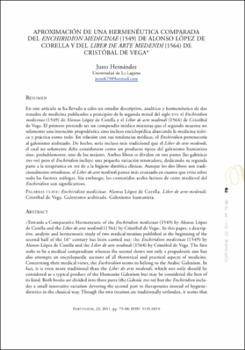Aproximación de una hermenéutica comparada del Enchiridion medicinae (1459) de Alonso López de Corella y del Liber de arte medendi (1564) de Cristóbal de Vega
Date
2011Abstract
En este artículo se ha llevado a cabo un estudio descriptivo, analítico y hermenéutico de dos tratados de medicina publicados a principios de la segunda mitad del siglo XVI: el Enchiridion medicinae (1549) de Alonso López de Corella y el Liber de arte medendi (1564) de Cristóbal de Vega. El primero pretende ser un compendio médico mientras que el segundo muestra no solamente una intención propedéutica sino incluso enciclopédica abarcando la medicina teórica y práctica como todo. En relación con sus tendencias médicas, el Enchiridion pertenecería al galenismo arabizado. De hecho, sería incluso más tradicional que el Liber de arte medendi, el cual no solamente debe considerarse como un producto típico del galenismo humanista sino, probablemente, uno de los mejores. Ambos libros se dividen en tres partes (las galénicas tres res) pero el Enchiridion incluye una pequeña variación renovadora, dedicando su segunda parte a la terapéutica en vez de a la higiene-dietética clásicas. Aunque los dos libros son tradicionalmente ortodoxos, el Liber de arte medendi parece más avanzado en cuanto que evita sobre todo las fuentes arábigas. Sin embargo, los contenidos arabo-latinos de corte medieval del Enchiridion son significativos. In this paper, a descriptive, analytic and hermeneutic study of two medical treatises published at the beginning of the second half of the 16th century has been carried out: the Enchiridion medicinae (1549) by the Liber de arte medendi is more advanced mainly in terms of its avoidance of Arabic sources.
However, the medieval type arabo-latin contents of the Enchiridion merit attention.
Alonso López de Corella and the Liber de arte medendi (1564) by Cristóbal de Vega. The first seeks to be a medical compendium whereas the second shows not only a propedeutic aim but also attempts an encyclopaedic account of all theoretical and practical aspects of medicine.
Concerning their medical views, the Enchiridion seems to belong to the Arabic Galenism. In fact, it is even more traditional than the Liber de arte medendi, which not only should be considered as a typical product of the Humanist Galenism but may be considered the best of its kind. Both books are divided into three parts (the Galenic tres res) but the Enchiridion includes a small innovative variation devoting the second part to therapeutics instead of hygienedietetics in the classical way. Though the two treatises are traditionally orthodox, it seems that.






